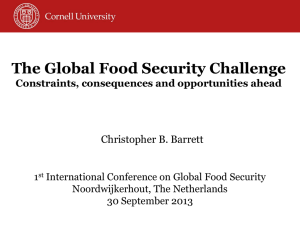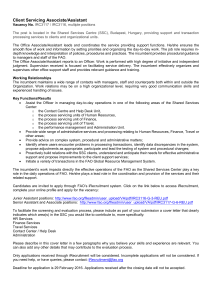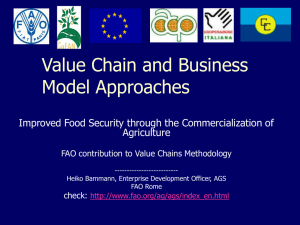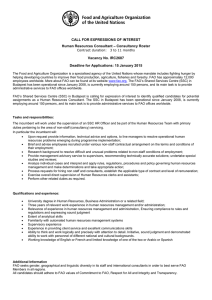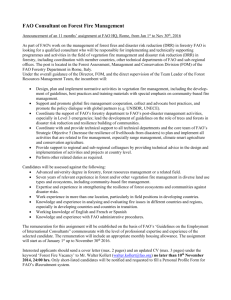Registration / Licensing Policy
advertisement
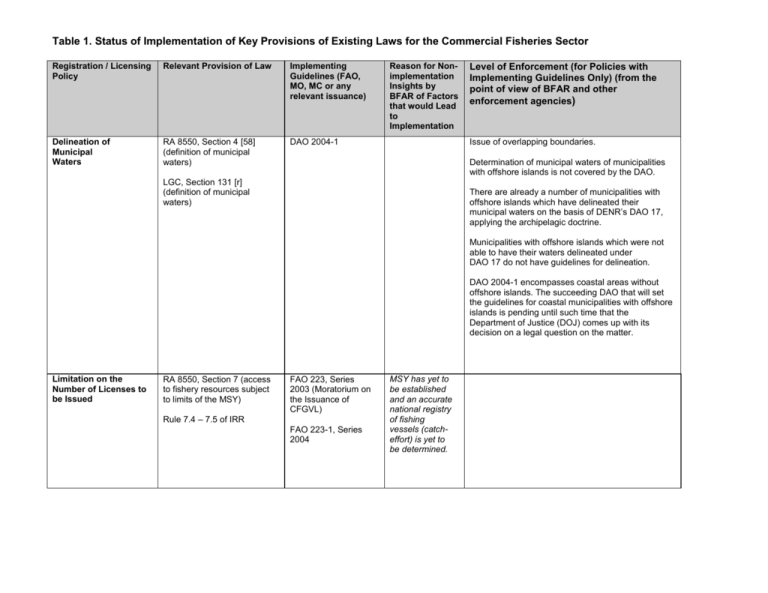
Table 1. Status of Implementation of Key Provisions of Existing Laws for the Commercial Fisheries Sector Registration / Licensing Policy Relevant Provision of Law Implementing Guidelines (FAO, MO, MC or any relevant issuance) Delineation of Municipal Waters RA 8550, Section 4 [58] (definition of municipal waters) DAO 2004-1 Reason for Nonimplementation Insights by BFAR of Factors that would Lead to Implementation Level of Enforcement (for Policies with Implementing Guidelines Only) (from the point of view of BFAR and other enforcement agencies) Issue of overlapping boundaries. Determination of municipal waters of municipalities with offshore islands is not covered by the DAO. LGC, Section 131 [r] (definition of municipal waters) There are already a number of municipalities with offshore islands which have delineated their municipal waters on the basis of DENR’s DAO 17, applying the archipelagic doctrine. Municipalities with offshore islands which were not able to have their waters delineated under DAO 17 do not have guidelines for delineation. DAO 2004-1 encompasses coastal areas without offshore islands. The succeeding DAO that will set the guidelines for coastal municipalities with offshore islands is pending until such time that the Department of Justice (DOJ) comes up with its decision on a legal question on the matter. Limitation on the Number of Licenses to be Issued RA 8550, Section 7 (access to fishery resources subject to limits of the MSY) FAO 223, Series 2003 (Moratorium on the Issuance of CFGVL) Rule 7.4 – 7.5 of IRR FAO 223-1, Series 2004 MSY has yet to be established and an accurate national registry of fishing vessels (catcheffort) is yet to be determined. TACs Catch Ceiling Limitations Closed Seasons RA 8550, Section 7 (access to fishery resources subject to limits of the MSY) Rule 7.1 of IRR RA 8550, Section 8 (catch ceiling limitations) RA 8550 Section 8 Rule 8.1 – 8.2 of IRR RA 8550, Section 9 Rule 9.1 – 9.3 of IRR *No FAO on TAC has been enacted yet TAC has not yet been determined. *No FAO on catch ceiling has been enacted yet. MSY has not been established. *No FAO declaring closed season has been enacted after the effectivity of RA 8550 MSY has not been established. Closed season is difficult to impose considering the multiplicity of fish species being managed. License Fees Based on Resource Rent RA 8550, Section 6 FAO 198, Series 2000 (Rules and Regulations on Commercial Fishing), Section 9 Basis for the license fees is the gross tonnage of the vessel and not resource rent. Fee for fish caught is not recognized in current licensing / registration schemes. Fees are most often based on recovery of administrative costs and service expenses. Area-based Licenses RA 8550, Section 26 Rule 26.1 of IRR Rule 7.7 (Preferential Allocation of CFVL to large fishing vessels to encourage fishing in the EEZ and beyond.) Rule 40.1 – 40.3 of IRR FAO 198, Section 5 (c) Applicant for license identifies his proposed fishing area. The extent of the EEZ should be determined with certainty. Overlapping claims in EEZ. Gear Restrictions / Accessories RA 8550, Sections 6, 29, 44, 88, 89, 90, 92 FAO 84, 1965 (Prohibiting electrofishing) FAO 122, Series 1977 (Prohibiting the use of pantukos under certain conditions) FAO 155, Series 1986 (Regulating the use of fine-meshed nets) FAO 163, Series 1986 (Prohibiting the operation of muroami and kayakas) FAO 164, Series 1987 (R&R for hulbot-hulbot) FAO 188, Series 1993 (R&R for tuna purse seine nets for commercial fishing) FAO 190, Series 1994 (Regulations re: pa-aling) FAO 201, Series 2000 (Ban on fishing with active gear) FAO 203, Series 2000 (Ban on muro-ami) FAO 204, Series 2000 (Restricting use of superlights) FAO 222, Series 2003 (Regulations on hulbot-hulbot) Gear restriction is regulated outright at the stage where registration and licenses are applied for. Some gears are used without undergoing registration and licensing. Enforcement of gear restrictions is weak. Enforcement agencies and officers lack resources to effectively undertake enforcement activities. Incentives for enforcement agencies and officers are lacking. Apprehension may be undertaken only if fisherfolk is caught in flagrante delicto (i.e., fisherfolk is in actual use of the prohibited gear). This does not apply to fishing through explosives, noxious or poisonous substances or electro-fishing where mere possession of such gear constitute prima facie evidence that the same was used for fishing. Limitation of Entry RA 8550, Section 23 Rule 23.1 – 23.3 of IRR *FAO on guidelines on overfishing / criteria for determining overfished area not yet issued. RA 8550, Section 26 FAO 194, Series 1998 (Moratorium on commercial fishing vessels in Lingayen Gulf) RA 8550, Section 80 (Fishery reserves for exclusive use of government) FAO 198 Section 25 RA 8550, Section 81 (Fish refuge and fish sanctuaries) Reportorial Requirements Rule 81.1 RA 8550, Section 38 Rule 38.1 Fines and Penalties RA 8550, Sections 86, 89, 90, 92, 93, 95, 101, 103 [a], 104 Qualifications of Licensees 1987 Constitution, Article XII, Section 2 RA 8550, Sections 2(b) 17, 18, 19, 21, 27 FAO 198, Section 25 FAO 198, Section 22 This shall be based on scientific studies and best available evidence. Basis is best available scientific data. Basis is best available scientific data. Not fully implemented. Imposition of appropriate fines and penalties depends on the successful prosecution of violators. Unfortunately, not all prosecutors and judges have a good grasp of fishery laws, rules and regulations. FAO 198 Section 3 LGU Ordinance Citizenship requirement is strictly imposed. Insofar as juridical entities (i.e., corporations) are concerned, the burden of proving that 60% Filipino ownership is upon said entity. Incentives RA 8550, Section 34 (for Municipal and Smallscale Commercial Fisherfolk) No FAO Section 35 (for Commercial Fishers to Fish Farther into the EEZ) Funds RA 8550, Section 109 (Municipal Fisheries Grant Fund) Section 110 (Fishery Loan and Guarantee Fund) Section 111 (Fishing Vessels Development Fund) Section 112 (Special Fisheries Science and Approfishtech Fund) Criteria for Licensing Article XII, Section 2, par. 2, 1987 Constitution RA 8550 Sections 26, 30, 31, 38 Citizenship requirement is strictly imposed. Insofar as juridical entities (i.e., corporations) are concerned, the burden of proving that 60% Filipino ownership is upon said entity. FAO 198, Series 2000 FAO 223, Series 2004 FAO 223-1, Series 2004 MMC 110, Series 1995 Rule 7.6 (Priority rights of present licensees of CFBL [CFVGL] provided there is no record of violation of terms and conditions of the license) Rule 7.8 (Defining the criteria for granting licenses to small and medium-sized commercial vessels.) No known extensive evaluation study conducted regarding the technical capability of small and medium commercial fishing vessels to fish beyond municipal waters. Article XII, Section 2, par. 2, 1987 Constitution Criteria for Registration RA 8550, Section 28 Citizenship requirement is strictly imposed. Insofar as juridical entities (i.e., corporations) are concerned, the burden of proving that 60% Filipino ownership is upon said entity. MMC 179, Series 2002 (Minimum Safe Manning Certificate) MMC 172, Series 2002 (Pro-poor vessel fees) RA 9295 (Domestic Shipping Development Act) The process of reporting and recording of violations of licenses should be streamlined. MMC 90, Series 1994 (Guidelines for vessel registration) *No IRR yet Monitoring and Enforcement RA 8550, Sections. 14, 65 (k), (n) Rule 14.1 of IRR The Bureau has embarked on monitoring, control and surveillance (MCS) solely depending on its meager resources and in collaboration with specific agencies, such as the PNP-MG and the PCG. The acquired patrol vessels from the Spanish Government through a soft loan have been deployed to critical regions where rampant illegal fishing particularly those by foreign nationals are occurring. Surveillance schemes are being harmonized with the municipalities and EEZ monitoring. The coordination with the Department of National Defense has not materialized despite several discussions for possible joint MCS as the modernization of the Armed Forces of Philippines fund which the project depended on was never approved and the equipment and assets requested were not delivered. However, the BFAR is continuing talks specifically with the Philippine Navy to harmonize rules of engagement with regard to foreign illegal fishers. The Department of Foreign Affairs has established the National Committee on Illegal Entrants that deals with foreign intrusions including fishing activities and the BFAR sits in this committee with other concerned agencies.

